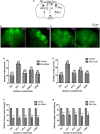Adult health and transition stage-specific rotenone-mediated Drosophila model of Parkinson's disease: Impact on late-onset neurodegenerative disease models
- PMID: 36017079
- PMCID: PMC9398202
- DOI: 10.3389/fnmol.2022.896183
Adult health and transition stage-specific rotenone-mediated Drosophila model of Parkinson's disease: Impact on late-onset neurodegenerative disease models
Abstract
Parkinson's disease (PD) affects almost 1% of the population worldwide over the age of 50 years. Exposure to environmental toxins like paraquat and rotenone is a risk factor for sporadic PD which constitutes 95% of total cases. Herbicide rotenone has been shown to cause Parkinsonian symptoms in multiple animal models. Drosophila is an excellent model organism for studying neurodegenerative diseases (NDD) including PD. The aging process is characterized by differential expression of genes during different life stages. Hence it is necessary to develop life-stage-matched animal models for late-onset human disease(s) such as PD. Such animal models are critical for understanding the pathophysiology of age-related disease progression and important to understand if a genotropic drug/nutraceutical can be effective during late stages. With this idea, we developed an adult life stage-specific (health and transition phase, during which late-onset NDDs such as PD sets in) rotenone-mediated Drosophila model of idiopathic PD. Drosophila is susceptible to rotenone in dose-time dependent manner. Rotenone-mediated fly model of sporadic PD exhibits mobility defects (independent of mortality), inhibited mitochondrial complex I activity, dopaminergic (DAergic) neuronal dysfunction (no loss of DAergic neuronal number; however, reduction in rate-limiting enzyme tyrosine hydroxylase (TH) synthesis), and alteration in levels of dopamine (DA) and its metabolites; 3,4-Dihydroxyphenylacetic acid (DOPAC) and Homovanilic acid (HVA) in brain-specific fashion. These PD-linked behaviors and brain-specific phenotypes denote the robustness of the present fly model of PD. This novel model will be of great help to decipher life stage-specific genetic targets of small molecule mediated DAergic neuroprotection; understanding of which is critical for formulating therapeutic strategies for PD.
Keywords: Drosophila; Parkinson’s disease; dopamine; health phase; rotenone; transition phase.
Copyright © 2022 Ayajuddin, Phom, Koza, Modi, Das, Chaurasia, Thepa, Jamir, Neikha and Yenisetti.
Conflict of interest statement
The authors declare that the research was conducted in the absence of any commercial or financial relationships that could be construed as a potential conflict of interest.
Figures






Similar articles
-
Sexual dysfunction precedes motor defects, dopaminergic neuronal degeneration, and impaired dopamine metabolism: Insights from Drosophila model of Parkinson's disease.Front Neurosci. 2023 Mar 21;17:1143793. doi: 10.3389/fnins.2023.1143793. eCollection 2023. Front Neurosci. 2023. PMID: 37025374 Free PMC article.
-
Activation of cyclic AMP signaling pathway in dopaminergic neurons rescues locomotion defects in a Drosophila larval model of Parkinson's disease.Brain Res. 2024 Jan 1;1822:148641. doi: 10.1016/j.brainres.2023.148641. Epub 2023 Oct 21. Brain Res. 2024. PMID: 37866407 Free PMC article.
-
Chronic exposure to rotenone models sporadic Parkinson's disease in Drosophila melanogaster.J Neurosci. 2004 Dec 1;24(48):10993-8. doi: 10.1523/JNEUROSCI.2993-04.2004. J Neurosci. 2004. PMID: 15574749 Free PMC article.
-
Chronic stress-induced gut dysfunction exacerbates Parkinson's disease phenotype and pathology in a rotenone-induced mouse model of Parkinson's disease.Neurobiol Dis. 2020 Feb;135:104352. doi: 10.1016/j.nbd.2018.12.012. Epub 2018 Dec 21. Neurobiol Dis. 2020. PMID: 30579705 Review.
-
Paraquat- and rotenone-induced models of Parkinson's disease.Int J Immunopathol Pharmacol. 2011 Apr-Jun;24(2):313-22. doi: 10.1177/039463201102400205. Int J Immunopathol Pharmacol. 2011. PMID: 21658306 Review.
Cited by
-
Paracentrotus lividus sea urchin gonadal extract mitigates neurotoxicity and inflammatory signaling in a rat model of Parkinson's disease.PLoS One. 2024 Dec 18;19(12):e0315858. doi: 10.1371/journal.pone.0315858. eCollection 2024. PLoS One. 2024. PMID: 39693313 Free PMC article.
-
Gene Set Enrichment Analysis and Genetic Experiment Reveal Changes in Cell Signaling Pathways Induced by α-Synuclein Overexpression.Biomedicines. 2023 Jan 18;11(2):263. doi: 10.3390/biomedicines11020263. Biomedicines. 2023. PMID: 36830800 Free PMC article.
-
Chemical Characterization and Beneficial Effects of Walnut Oil on a Drosophila melanogaster Model of Parkinson's Disease.Molecules. 2024 Sep 4;29(17):4190. doi: 10.3390/molecules29174190. Molecules. 2024. PMID: 39275038 Free PMC article.
-
Fluorescence microscopy-based sensitive method to quantify dopaminergic neurodegeneration in a Drosophila model of Parkinson's disease.Front Neurosci. 2023 Jun 26;17:1158858. doi: 10.3389/fnins.2023.1158858. eCollection 2023. Front Neurosci. 2023. PMID: 37434762 Free PMC article.
-
Sexual dysfunction precedes motor defects, dopaminergic neuronal degeneration, and impaired dopamine metabolism: Insights from Drosophila model of Parkinson's disease.Front Neurosci. 2023 Mar 21;17:1143793. doi: 10.3389/fnins.2023.1143793. eCollection 2023. Front Neurosci. 2023. PMID: 37025374 Free PMC article.
References
-
- Andersen A. D., Blaabjerg M., Binzer M., Kamal A., Thagesen H., Kjaer T. W., et al. (2017). Cerebrospinal fluid levels of catecholamines and its metabolites in Parkinson’s disease: Effect of l-DOPA treatment and changes in levodopa-induced dyskinesia. J. Neurochem. 141 614–625. 10.1111/jnc.13997 - DOI - PubMed
-
- Arking R. (2009). “Overview of the genomic architecture of longevity,” in Life span extension: Single cell organisms to man, eds Sell C., Lorenzini A., Brown-Borg H. M. (Dordrecht: Humana Press; ), 59–73. 10.1186/s12864-019-6066-6 - DOI
LinkOut - more resources
Full Text Sources
Molecular Biology Databases

